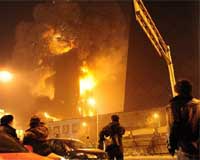| . |  |
. |
Corvallis OR (SPX) Feb 26, 2010 With a changing climate there's a good chance that forest fires in the Pacific Northwest will become larger and more frequent - and according to one expert speaking recently at a professional conference, that's just fine. The future of fire in this region is difficult to predict, will always be variable, and undoubtedly a part of the future landscape. People should understand, however, that fire is not only inevitable but also a valuable part of forest ecosystems and their management, says John Bailey, an associate professor in the Department of Forest Engineering, Resources and Management at Oregon State University. Bailey will speak as one of many invited experts at "Forest Health in Oregon: State of the State," a conference being held at Oregon State University. He describes fire as a force that should be understood, often welcomed, used as appropriate and more frequently incorporated into long-term ecosystem management. "Forests historically had more fire across much of Oregon, and they would love to have more today," Bailey said. "Burning is a natural ecosystem process and generally helps restore forest ecosystems. It's ironic that we spend so much money to stop fire, because we should learn to see fire as more of a partner and not always an enemy." Many experts are warning that global warming and drought stress in forests may make them more vulnerable to frequent, larger and hotter fires, Bailey said. That may be true, he added, although future predictions can't be made with a high degree of certainty, and there will still be a wide amount of variation in the types of fires and acreages burned in various years. But the more important point, he emphasized, is that even if some of the more dire scenarios are true, they shouldn't necessarily be seen as a crisis. Frequent fire in Pacific Northwest forests will promote forest composition, structure and function that's more consistent with how these forests grew historically. Prior to European settlement, fires were significantly more frequent, sometimes were started on purpose and rarely suppressed. "Right now we're spending billions of dollars to prevent something that is going to happen sooner or later, whether we try to stop it or not, and something that can assist us in sound land management," Bailey said. "It may always make sense to put out some fires when they threaten communities, or in other select circumstances. "But periodic fire has always been a part of our forests, and we need to accept it as such, sort of like how we plan for and accept a very wet winter that comes along now and then," he said. Fire regimes vary widely based on fuel loads, topography and weather in the short term, and forces such as fire suppression, forest management and climate changes in the long term, Bailey said. They can be linked to droughts, insect attack and other factors that are all a natural part of the forest. But the key to the future, he said, is accepting the inevitability of fire and learning to manage it as a natural part of the ecosystem. That may take a substantial culture shift, he conceded, when much of the public and even government agencies have traditional ways of looking at fire and resource loss, consider all forest fire as bad, and even organize large, commercially important systems based around fire suppression. Much recent research, however, has explored the ways in which fire helps treat fuel loading issues within stands and across landscapes; reduces competition for moisture and nutrients; develops complex forest structure; helps maintain the health of surviving trees and leaves them better able to resist disease and insect attack; and sometimes sets the stage for forest renewal. Most burned area within the majority of Oregon fires are not stand-replacement situations, researchers have found. Their structure varies after a fire, usually as a result of pre-fire variability in the fuels, weather fluctuations and sometimes suppression activities. But proactive fuel management can lower the importance of suppression efforts. "The move to new viewpoints could not only help benefit our forests, but save a lot of money and be quite exciting for exploring the natural role of fire in our state," Bailey says. "We've had a wide range of forest conditions in the past and, despite whatever climate change may bring, we'll have a wide range in the future. And fire will be a part of it." The professional conference is exploring issues in Oregon forest health, current forest conditions, recent research, and management approaches for the future. It's being held Feb. 24-25 at the LaSells Stewart Center on the OSU campus, hosted by the OSU College of Forestry and Forestry Extension.
Share This Article With Planet Earth
Related Links Oregon State Forest and Wild Fires - News, Science and Technology
 China holds 71 responsible for state TV station fire tragedy
China holds 71 responsible for state TV station fire tragedyBeijing (AFP) Feb 11, 2010 China Wednesday blamed 71 people for a huge blaze at its new state television headquarters that engulfed a hotel, killed a fireman and left a 24-million-dollar clean-up bill, state media reported. One firefighter died after inhaling toxic fumes while battling the fire at the Mandarin Oriental's nearly finished flagship hotel inside the CCTV complex in February last year, while a further six ... read more |
|
| The content herein, unless otherwise known to be public domain, are Copyright 1995-2010 - SpaceDaily. AFP and UPI Wire Stories are copyright Agence France-Presse and United Press International. ESA Portal Reports are copyright European Space Agency. All NASA sourced material is public domain. Additional copyrights may apply in whole or part to other bona fide parties. Advertising does not imply endorsement,agreement or approval of any opinions, statements or information provided by SpaceDaily on any Web page published or hosted by SpaceDaily. Privacy Statement |